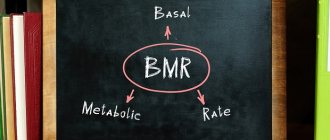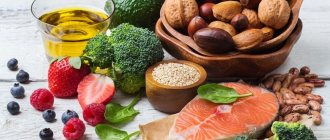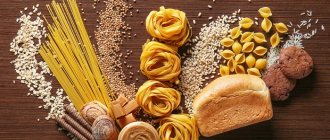4.3
Average rating: 4.3
Total ratings received: 1495.
4.3
Average rating: 4.3
Total ratings received: 1495.
In biology, metabolism is a set of closely interrelated processes that ensure the connection of living organisms with the environment. The purpose of metabolism is to create complex substances and supply the body with energy.
What it is?
Metabolism
is the processes that take place in any living organism to maintain its life.
Metabolism allows the body to grow, reproduce, heal damage, and respond to the environment. This really requires a constant metabolism
. Processes can be divided into two threads. One is destructive - catabolism, the other is creative - anabolism.
How to lose weight through sports?
Basic rules of training, diet and useful links in special material for those who want to lose weight.
Why study metabolism?
There are two main reasons to study the metabolic pathway:
- to quantitatively describe chemical changes catalyzed by component enzymes of the pathway;
- describe the various intracellular controls that determine the rate at which this pathway functions.
Studies with whole organisms or organs can provide information that one substance is converted into another and that this process is localized to a specific tissue. For example, experiments may show that urea, the major nitrogen-containing end product of protein metabolism in mammals, is produced exclusively in the liver. However, they cannot reveal the details of the enzymatic steps involved. Clues to the identity of the products involved and to possible chemical changes caused by the component enzymes can be provided by any of four methods, including studies of whole organisms or tissues.
First, under conditions of stress or disease-related imbalances, certain metabolites may accumulate to a greater extent than normal. Thus, during the stress of intense exercise, lactic acid appears in the blood and glycogen, the form in which carbohydrates are stored in muscles, disappears. Such observations, however, do not prove that lactic acid is a normal intermediate in glycogen catabolism; rather, they show only that compounds capable of producing lactic acid may be normal intermediates. Indeed, in this example, lactic acid is produced in response to abnormal circumstances and is not produced directly by carbohydrate catabolic pathways.
Secondly, the introduction of metabolic poisons can lead to the accumulation of specific metabolites. For example, if fluoroacetic acid is ingested by animals, citric acid accumulates in the liver. This correctly indicates that fluoroacetic acid, administered as such or generated from fluoroacetic acid through the tricarboxylic acid cycle (TCA cycle), inhibits the citrate oxidation enzyme.
Third, the fate of any nutrient—indeed, often the fate of a particular chemical group or atom in a nutrient—can be monitored relatively easily by the introduction of an isotope-labeled nutrient. Isotopes are forms of an element that are chemically indistinguishable from each other but differ in physical properties.
The use of a non-radioactive isotope of nitrogen in the 1930s was the first to show the dynamic state of the body's constituents. Previously, it was believed that tissue proteins were stable after formation and disappeared only with death in the cell. By feeding rats with amino acids labeled with isotopic nitrogen, it was found that the isotope was incorporated into many of the amino acids contained in liver and intestinal proteins, even though the total protein content of these tissues did not change. This suggests that the proteins in these tissues exist in a dynamic steady state in which relatively high rates of synthesis are balanced by equal rates of degradation. Thus, although the average liver cell has a lifespan of several months, half of its proteins are synthesized and degraded every five to six days. On the other hand, proteins in the muscles or brain, tissues that (unlike the intestines or liver) do not need to adapt to changes in the chemistry of their environment, do not renew themselves as quickly.
Finally, genetically modified organisms (mutants) are unable to synthesize certain enzymes in an active form. Such defects, if not lethal, result in accumulation and excretion of the substrate of the defective enzyme; in normal organisms the substrate will not accumulate because it will be acted upon by the enzyme. The significance of this observation was first realized in the early 20th century, when the phrase "inborn errors of metabolism" was used to describe inherited conditions in which various amino acids and other metabolites are excreted in the urine. In microorganisms in which genetic mutations are relatively easy to induce, this method has been very useful for selecting specific mutations. In addition to their usefulness in unraveling metabolic pathways, the use of mutants in the early 1940s led to the postulation of the one gene-one enzyme hypothesis (by Nobel Prize winners George Beadle and Edward L. Tatum); their discoveries opened up the field of biochemical genetics and revealed for the first time the nature of the fine control of metabolism.
Because detailed mechanistic information about the components of enzymatic steps in any metabolic pathway cannot be obtained from studies with whole organisms or tissues, various methods have been developed to study these processes—for example, sliced tissues and homogenates and cell-free extracts that are produced by physically disrupting cells and removing cell walls and other debris. The cut tissue technique was successfully used by Nobel Prize winner Hans Krebs in his early 1930s studies of the mechanism of urea formation in the liver. Measurements have been made of the stimulating effects of small amounts of amino acids on both the rate of oxygen uptake and the amount of oxygen absorbed; amino acids were added to liver slices bathed in a nutrient medium. Such measurements revealed the cyclical nature of the process; specific amino acids acted as catalysts, stimulating respiration to a degree greater than expected from added amounts. This occurred because the added material was re-formed during the cycle.
It should be emphasized that biochemists understand that studies of isolated and highly purified systems, such as those briefly described above, can only approximate biological reality. Identification of the fine and coarse controls of a metabolic pathway and (if appropriate) other influences on the pathway must ultimately involve studying the pathway throughout the cell or organism. Although some methods have proven adequate to compare in vitro results with the in vivo situation, studying more complex metabolic processes, such as those involved in differentiation and development, may require the development of new experimental approaches.
Disassembly at the molecular level...
Any nutrient that enters the body cannot immediately be used for its needs. For example, proteins
from nuts, milk and human muscles are completely different and cannot replace each other.
However, they consist of the same “building blocks” - amino acids
.
Although each of the proteins has a different set and ratio. To obtain building material for, for example, biceps, special enzymes disassemble the protein contained in milk or cutlet into individual amino acids
, which are already used.
At the same time, energy is released, measured in calories. The process of disassembly is catabolism
. Another example of catabolism is the breakdown of regular refined sugar into fructose and glucose.
Autotrophs
Autotrophs (from the Greek autos - self and trophe - food, nutrition) are organisms capable of synthesizing organic compounds from inorganic ones using a certain type of energy. There are phototrophs and chemotrophs.
Phototrophs
Phototrophs (from the Greek photos - light) are organisms that use light energy for the processes of synthesis of organic compounds from inorganic ones. These include some prokaryotes (photosynthetic sulfur bacteria and cyanobacteria) and green plants.
Chemotrophs
Chemotrophs (from the Greek chemia - chemistry) use the energy of chemical reactions to synthesize organic compounds from inorganic ones. These include some prokaryotes (iron bacteria, sulfur bacteria, nitrogen-fixing bacteria, etc.). Autotrophic processes relate more to assimilation processes.
... and assembly shop
It is not enough for the body to disassemble proteins from what it eats into amino acids. From them it is necessary to assemble new proteins
for the same biceps muscle.
Myths and truth about losing weight
Is it possible to lose a few kilos in one workout, are muscle stimulants useful, and other stories for the lazy.
Building complex molecules from smaller components requires energy.
It uses the same calories that the body received during the “disassembly”. This process is called anabolism
. A couple more clear examples of the work of the body’s “assembly shop” are the growth of nails and the healing of cracks in bones.
Where does fat come from?
If the process of breaking down nutrients produces more energy than is required for the construction of new body cells, there is a clear excess
that needs to be put somewhere.
When the body is at rest, metabolism occurs in the “background” mode and does not require active breakdown and synthesis of substances. But as soon as the body begins to move, all processes accelerate and intensify. The need for energy and nutrients also increases. But even an active organism may still have excess calories
if it comes in too much from food.
A small part of the received and unspent energy is stored in the form of glycogen
- a source of energy for active muscle work.
It is stored in the muscles and liver themselves. The rest accumulates in fat cells
. Moreover, their formation and life require much less energy than building muscles or bones.
Catabolism and anabolism
Metabolic synthesis consists of catabolism and anabolism. You can understand them in more detail by looking at the diagram:
Catabolic mechanisms are a set of reactions leading to the breakdown of complex organic molecules into simple ones, which is accompanied by the synthesis of energy. This type of exchange is called energy, or dissimilation.
During the process of catabolism, organic components decompose into simple compounds (carbon dioxide, water, nitrogen compounds) and adenosine triphosphate (ATP) molecules, which are a source of energy for the cell. The final stage of product breakdown is amphibolism.
ATP is a high-energy mononucleotide that is stored in cellular structures and spent on synthesis processes - anabolism.
The definition of anabolic synthesis or plastic metabolism is that during the reaction process complex organic molecules are synthesized from simple compounds. Assimilation includes chemo and photosynthesis, synthesis of proteins and carbohydrates, etc. These actions actively use the energy of ATP, which was formed during the dissimilation of nutritional components. Here the type of nutrition of the body plays an important role - heterotrophs rearrange molecules, and autotrophs are capable of synthesis from scratch.
Both processes occur with the participation of enzymes, which catalyze (or inhibit) the stages of the mechanisms as needed and serve as signaling molecules in the event of sudden changes in the body.
Plastic and energy balance are inextricably linked, since the formation of energy during one is consumed by the reactions of the second. The inverse relationship is that all steps of energy metabolism can only exist in the presence of enzymes synthesized during assimilation. The stages are presented in the table:
Regulation of all metabolic processes occurs in two ways - nervous and humoral. The neural pathway, through the hypothalamus, regulates the level of organic compounds, their breakdown, and the balance of heat and energy. Humoral type - hormonal stimuli that regulate the permeability of cell membranes, the activity and transport of enzymes.
How is metabolism related to body weight?
We can say that body weight is catabolism minus anabolism
.
In other words, the difference between the amount of energy entering the body and the amount used by it. So, one gram of fat eaten gives 9 kcal, and the same amount of protein or carbohydrate gives 4 kcal. The body will store the same 9 kcal into 1 gram of fat in its body if it fails to spend it. A simple example
: you eat a sandwich and lie down on the sofa. From bread and sausage, the body received fats, proteins, carbohydrates and 140 kcal. In this case, the lying body will spend the resulting calories only on breaking down the food eaten and a little on maintaining the functions of breathing and circulation - about 50 kcal per hour. The remaining 90 kcal will turn into 10 g of fat and be deposited in the fat depot. If a sandwich lover goes for a quiet walk, the body will burn the resulting calories in about an hour.
Composition and characteristics
The metabolic processes of digestion and assimilation of food have 3 specific goals:
- generation of cellular energy;
- the formation of building structures for proteins, lipids, carbohydrates and the removal of waste by-products from the body;
- all this contributes to normal vital processes and development of the body.
Metabolism regulation begins with the entry of nutrients into the body and ends with the removal of decay products. The main participants in the exchange are proteins, fats, carbohydrates, lipids, vitamins and water.
“Good” and “bad” metabolism?
Many look with envy at the fragile girl who regularly feasts on cakes and does not gain an ounce of weight. It is generally accepted that such lucky people have a good metabolism, while those for whom a piece of sugar in their tea threatens weight gain have a poor metabolism. In fact, research results show that truly slow metabolism is observed only in a number of diseases
, for example, hypothyroidism - a lack of thyroid hormone. And most overweight people do not have any diseases, but there is an energy imbalance. That is, much more energy enters the body than is actually needed, and it is stored in reserve.
Lipid class
One lipid molecule stores much more energy than a carbohydrate molecule. But at the same time, the process of oxidation of the lipid class is much more complex and longer. The primary breakdown of lipids occurs to glycerol and fatty acids, which are absorbed in the small intestine. Lipid interaction is regulated by the endocrine glands (pancreas).
In addition to storing energy, fats have several other important functions:
- The energy obtained during the breakdown of lipids goes to the work of muscles, kidneys and liver.
- All cell membranes are built on the basis of lipids (two-layer structure to maintain hydrophobicity and hydrophilicity).
- Fats are part of hormones and neurotransmitters.
- Fatty layers protect internal organs from shock and damage.
- The lipid layer is an ideal way of thermoregulation in the body.
When there is an excess of lipids, they begin to be deposited, which leads to obesity. If there is a deficiency, proteins and carbohydrates can be transformed into lipids.
What you need to know about metabolism
The entire life of an organism is a balance between the breakdown of nutrients and the production of energy from them and energy expenditure in the creation of new molecules and cells.
If too much energy is supplied, it is stored in reserve in the form of adipose tissue. You can increase energy expenditure by moving a lot or growing a sufficient amount of muscle mass. Tags:
- Women
- Men
- Metabolism
- Weight loss
1 comment • To leave a comment you must be an authorized user
- twatpw0tja0 Thanks for the article.
The essence of metabolism
The metabolic process is the transformation of chemicals necessary for the full functioning of all systems of the human body. Body systems and tissues require components with low-level structure. With food we receive high-level components that require breakdown.
Metabolism is two types of processes related to each other:
- catabolism - the breakdown of complex elements into simpler ones; as a result of decay, energy is generated;
- anabolism - the formation of substances necessary for the body from externally obtained components; as a result, new cells and tissues are formed; Such processes require large amounts of energy.
The pattern of flow and alternation of processes is very complex. But a basic understanding of both is important both for the fight against excess weight and for gaining mass.
© llhedgehogll — stock.adobe.com
Protein metabolism
Protein metabolism is the breakdown of protein into amino acids and the subsequent cascade of biochemical reactions with the products of their breakdown. Any strength athlete knows that protein is the most important component for building and generating muscle tissue. But, besides this, protein also performs other, no less important, functions:
- distributes nutrients throughout the body;
- ensures normal functioning of the endocrine system;
- promotes the formation of sex hormones;
- accelerates the rate of biochemical processes;
- blood transfer of oxygen, fats, a number of vitamins, minerals, carbohydrates, hormones and other components;
- plays a role in the consistency and usefulness of the functions of the immune system.
Protein metabolism consists of the following stages (source - Wikipedia):
- protein intake into the body;
- denaturation of elements to first-order proteins;
- splitting into individual amino acids;
- transportation of amino acids throughout the body;
- building tissue (for athletes this means primarily building muscles);
- a new cycle of protein metabolism - at this stage, the metabolism of proteins not used in construction occurs;
- removal of spent amino acids.
The amino acid complex is extremely important for proper metabolism. The amount of protein itself is of little importance.
When solving sports and nutritional problems, it is necessary to monitor the composition of the components.
This is especially true for vegetarians, since products of plant origin lack the necessary set of elements.
Fat metabolism
Fats are an important source of energy. During short-term physical activity, glycogen energy located in the muscles is first used. During prolonged exercise, the body obtains energy from fats. From understanding the characteristics of fat metabolism, the conclusion arises that the breakdown of fat reserves requires quite a long and powerful work.
The body tries to keep most of the fats in reserve. Under normal conditions, only about 5% of fat is consistently excreted back. Lipid (fat) metabolism occurs in several stages:
- breakdown of fats in the gastrointestinal tract, their digestion and absorption;
- transfer of lipids from the intestine;
- intermediate exchange reactions;
- processes of fat catabolism;
- catabolism of fatty acids.
Partial transformation of fats occurs in the stomach. But the process there is slow. The majority of lipid breakdown occurs in the upper region of the small intestine.
Much of the credit for lipid metabolism belongs to the liver.
Here, some of the components are oxidized, resulting in energy generation. The other part is broken down into transportable components and enters the blood.
© VectorMine — depositphotos.com. Fat metabolism
Carbohydrate metabolism
The main role of carbohydrate metabolism is determined by the energy value of the latter. The metabolic processes of these components account for about 60% of the body's total energy metabolism.
Without carbohydrates, full-fledged physical work is impossible.
That is why, for productive training, the basis of the diet should be “fuel” elements. At a basic level, carbohydrates are glucose. In the muscles and liver it accumulates in the form of glycogen.
An important concept related to carbohydrate metabolism is the glycemic index (GI). It reflects the rate at which carbohydrates are absorbed by the body and blood sugar rises. The GI scale is divided into 100 units, where 0 indicates carbohydrate-free foods, and 100 indicates foods rich in this component.
Based on this, products are divided into simple and complex. The first ones have a high GI, the second ones have a low GI.
© IrinaPotter — depositphotos.com. Glycemic index of foods
Understanding the difference between the two is very important. Simple carbohydrates are broken down very quickly into glucose. Thanks to this, within a few minutes the body receives a portion of energy. The downside is that the energy burst only lasts for 30-50 minutes. When consuming large amounts of fast carbohydrates:
- there is weakness, lethargy;
- fat reserves are deposited;
- the pancreas is damaged, which contributes to the formation of diabetes;
- the risk of developing cardiovascular diseases increases.
Complex carbohydrates take a long time to break down. But the impact from them is felt up to 4 hours. The diet should be based on elements of this type.
Low GI foods:
| Product | GI |
| Soybeans | 15 |
| Mushrooms | 15 |
| Cabbage | 15 |
| Lentils | 25 |
| Milk | 30 |
| Low-fat cottage cheese | 30 |
| Pasta (not fully cooked) | 40 |
| Buckwheat | 50 |
Medium GI foods:
| Product | GI |
| Spaghetti | 55 |
| Oatmeal | 60 |
| Long grain rice | 60 |
| Bananas | 60 |
| Pasta with cheese | 65 |
| Whole wheat bread | 65 |
| Jacket potatoes | 65 |
| Wheat flour | 65 |
High GI foods:
| Product | GI |
| White rice | 70 |
| Dumplings | 70 |
| Sweet carbonated drinks | 70 |
| Milk chocolate | 70 |
| Rice porridge with milk | 75 |
| Sweet pastries | 75 |
| Instant porridge | 85 |
| Honey | 90 |
| Rice noodles | 95 |
| Butter buns | 95 |
| White bread | 100 |
Exchange of water and minerals
Most of the body is water. The importance of metabolism in this context takes on a pronounced connotation. The brain consists of 85% water, blood - 80%, muscles - 75%, bones - 25%, adipose tissue - 20%.
Water is removed:
- through the lungs – 300 ml/day (on average);
- through the skin – 500 ml;
- with urine – 1700 ml.
The ratio of fluid consumed to excreted is called water balance. If intake is less than output, systems in the body fail. The rate of water consumption per day depends on the state of health, first of all.
In the absence of contraindications, for example, pathology of the kidneys, heart, blood vessels, etc., this is approximately 1.5-2.5 liters per day. This amount is enough to ensure good productivity and well-being.
But, with intense sweating, the proper level of water consumed can reach 6-7 liters (source - Federal State Budgetary Institution, Endocrinological Research Center of the Ministry of Health of the Russian Federation, Moscow. “Nutrition during sports.”) A dangerous condition for athletes is dehydration, which can only be prevented by calculation individual fluid needs.
The optimal norm of the required amount of fluid for a person per day must be calculated using the following formula:
- V=(M*0.03) + (T*0.4) - women;
- V=(M*0.04) + (T*0.6) — for men,
where, V is the volume of the required amount of water in liters per day, M is the person’s body weight, T is the time of direct exercise or other activity that requires energy expenditure (in the absence of these, 0 is set). This calculation takes into account all the required parameters: gender, weight and period of exposure to the body.
© OlhaYerofieieva — depositphotos.com. Average daily water consumption
Since minerals are also washed out of the body with water, for this reason it is advisable to supplement ordinary water with mineral water. This is one of the easiest ways to fill the shortage of necessary elements. It is recommended to calculate the norm of salts and minerals with the help of a nutritionist and create a diet based on these calculations.











